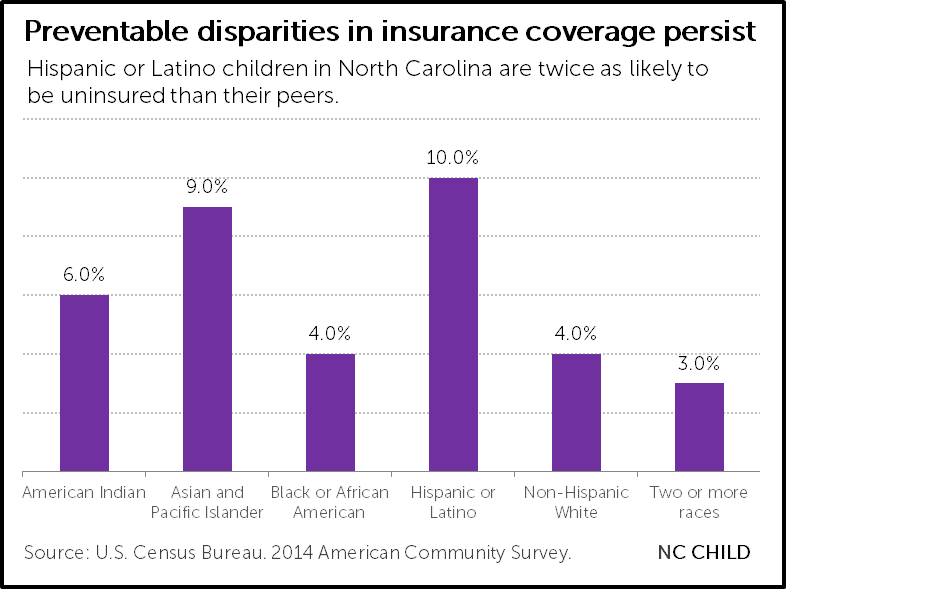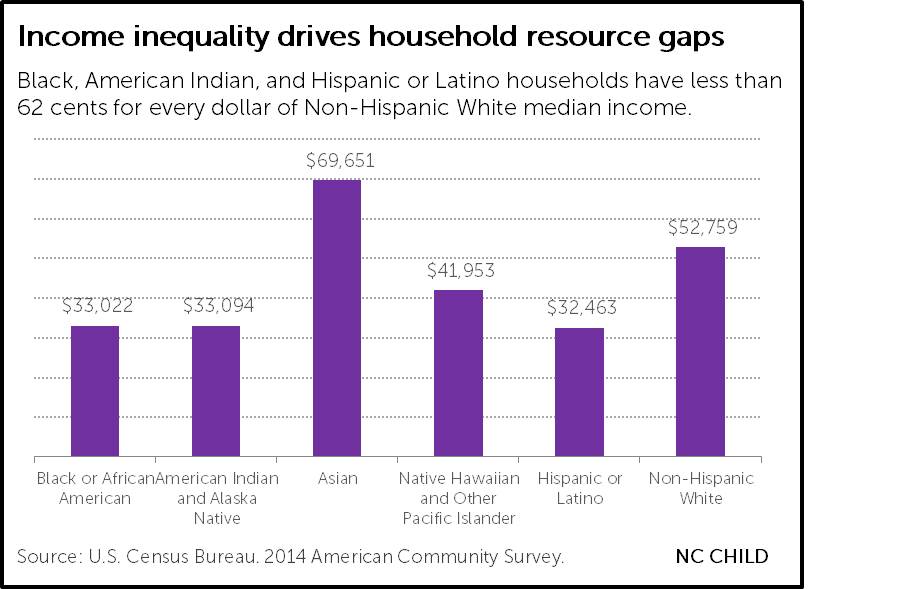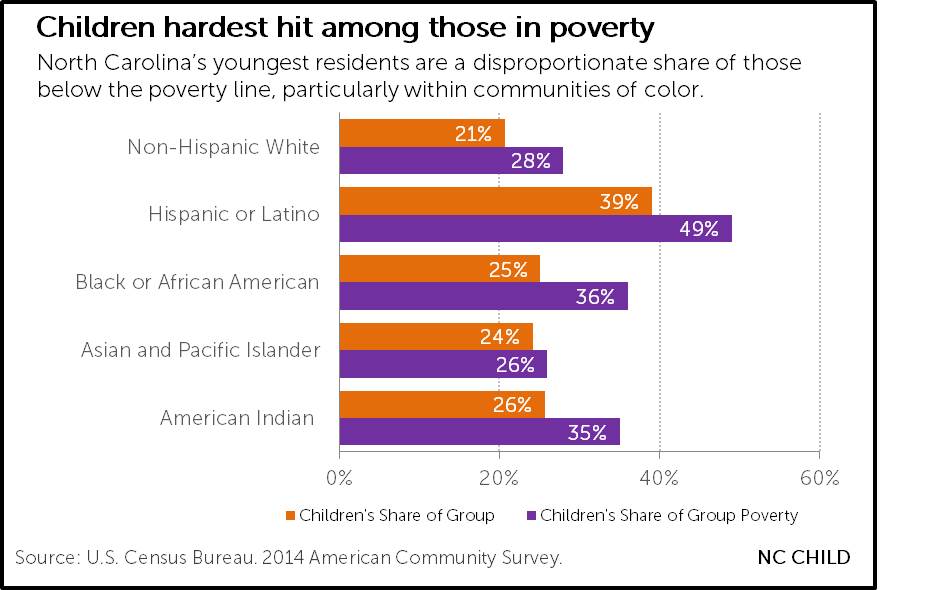By Laila A. Bell
Just after the General Assembly finalized a state budget and adjourned– following hot debates over where to invest state resources to grow the economy– the U.S. Census Bureau released data that show North Carolina families are economically stuck and more children are living in poverty than before the recession.
While the timing of the two events is coincidental, we should ask what state leaders can take from the data to inform decisions that ensure all families have the opportunity to achieve economic security and North Carolina enjoys shared prosperity. For our children this question is particularly pressing because their economic status is worse than any other age group.
Analysis of the 2014 American Community Survey data reveals the following trends that highlight needs and opportunities for North Carolina children and families:
1. More North Carolina children are insured than ever before.
The most encouraging news from the new Census data is an increase in the percentage of children with health insurance. Between 2013 and 2014, more than 25,000 children in North Carolina gained health insurance coverage, bringing the percentage of uninsured children down to 5.2 percent—a record low.
Since 2008–the first year the American Community Survey reported health insurance data –the percentage of uninsured children in North Carolina has declined faster than the national average.
Thanks to sustained investments in public health insurance programs, children gained coverage despite declining employer-sponsored health insurance.
Health insurance coverage is strongly related to better health and well-being for children. Insured children are more likely to receive a timely diagnosis of serious health conditions, experience fewer avoidable hospitalizations, and miss fewer days of school due to illness.
Despite improvements in children’s health insurance rates, coverage gaps exist. Latino children in North Carolina are twice as likely to be uninsured as their peers and Asian and Pacific Islander children are 1.7 times as likely to be uninsured. Low-income children (those who live in households that earn less than twice the federal poverty line) account for nearly two-thirds (63 percent) of uninsured children, despite being income eligible for NC Medicaid or NC Health Choice.
2. For the fifth consecutive year, household income remains flat signaling reduced purchasing power for North Carolina families.
Despite a slowly improving economy that has put more Tar Heel workers back on the job, the recovery has failed to put more money back into the pockets of North Carolina families, and the median family income is lower than it was before the recession–$46,556.
Household income has a profound impact on children’s development and well-being. Children in families with higher incomes are less likely to drop out of high school, more likely to enroll in or graduate from college, and are less likely live in poverty as an adult.
Income inequality has widened along racial and ethnic lines since the end of the Great Recession. In 2014, median incomes were $52,759 for White households, compared to $33,022 for African American, $33,094 for American Indian, and $32,463 for Hispanic or Latino households.
These estimates understate the true magnitude of North Carolina’s child poverty problem. This is because a larger portion of children experience poverty at some point during their childhood than are poor in any single given year. A national study found 40 percent of children in America spend at least one year in poverty before they turn 18.
3. Child poverty remains high.
Overall 24.3 percent of North Carolina children live in poverty, statistically unchanged from 2013. Although our child poverty rate has declined slightly from its post-recession peak of 26 percent in 2012 (586,000 children), it remains 25 percent higher than before the recession. The state’s youngest children have the highest poverty rates, with 27.3 percent of children under the age of five in poverty.
2014 Poverty Guidelines by Household Size
| Household Size | Poverty Guideline |
| 1 | $11,670 |
| 2 | $15,730 |
| 3 | $19,790 |
| 4 | $23,850 |
We know that official poverty guidelines are an inadequate measure of the financial resources needed to support a family. A recent statewide analysis found a family of four needs to earn more than twice the federal poverty income ($52,275) to make ends meet in North Carolina.
Poverty and economic hardship inflict real and lasting damage on child well-being. Poor and low-income children have fewer resources available to promote their healthy growth and development in the homes, communities, and schools where they live, learn, and play. The conditions that attend poverty—inadequate nutrition, substandard housing, exposure to family or community violence, and other forms of extreme stress—can be toxic to the very architecture of children’s brains, hampering development. Just as a faulty foundation weakens the strength and integrity of a house, economic hardship compromises children’s future learning, earnings, behavior, and health. Studies show the damage inflicted by poverty is intensified during the earliest years of a child’s life when the brain undergoes the most rapid period of growth and development.
Children of color are disproportionately likely to be poor. In 2014, Latino (42 percent), American Indian (39 percent) and African American (37 percent) children were two to three times as likely to live in poverty as their Non-Hispanic White peers (13 percent). If we expand the income boundaries to include low-income families, the gaps are astounding: three-quarters of Latino children and more than two-thirds of African American and American Indian children live in low-income homes.
The reach and persistence of poverty and economic hardship among children of color places them in a precarious position faced with considerable, preventable barriers to academic success, health and wellness, and future employment.
4. Racial and ethnic disparities remain wide and deep.
The Great Recession worsened preexisting gaps in income, poverty, and health insurance coverage between communities of color and their non-Hispanic White peers. Across a number of indicators, resource and opportunity gaps threaten the development and well-being of children of color. From parental education to preschool enrollment, the data show persistent disparities.
The Broader Context of the Data
When it comes to the well-being of children and youth, policy matters. Yet, the latest Census data show state investments are misaligned with North Carolina children’s most pressing needs. Recent legislative decisions have strained an already threadbare safety net for children and their families. North Carolina has allowed the Earned Income Tax Credit to sunset, has only partially restored income eligibility for child care subsidies, and failed to restore investments in early and K-12 education to keep pace with the needs of a changing child population and global economy.
The Census data also provides an important corrective. The Supplemental Poverty Measure –which takes into account the non-cash benefits provided by important family supports like tax credits and nutrition assistance—finds public investments prevented millions of children from dipping below the poverty line in 2014. For example, the federal Earned Income Tax Credit helped 10 million workers and 5.2 million children avoid poverty. More than just helping families mitigate poverty during difficult economic times, research shows investments like tax credits for working families and nutrition assistance also boost children’s long-term employment, education and health outcomes. To ensure North Carolina and its children can grow and thrive, these investments must be strengthened.
Despite a handful of good decisions that will prevent further regression, overall support for children’s early development remains inadequate and stuck at recession-era levels. Policymakers can and must take steps to strengthen investments in North Carolina’s youngest children to ensure that North Carolina will be economically competitive with other states and countries, today and in the future.




